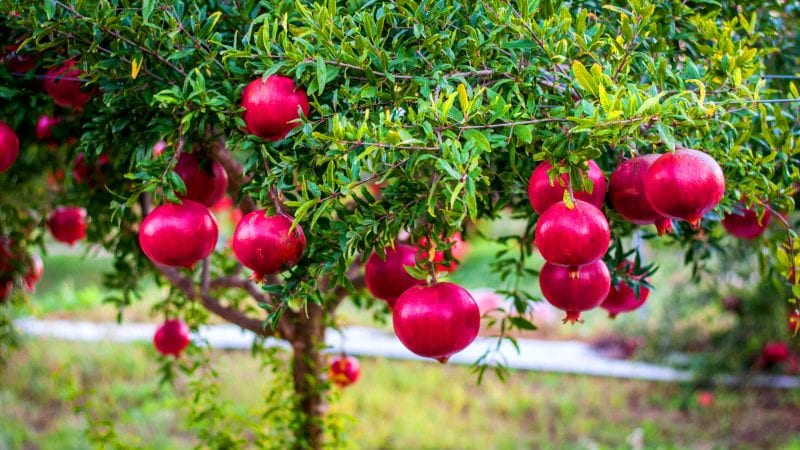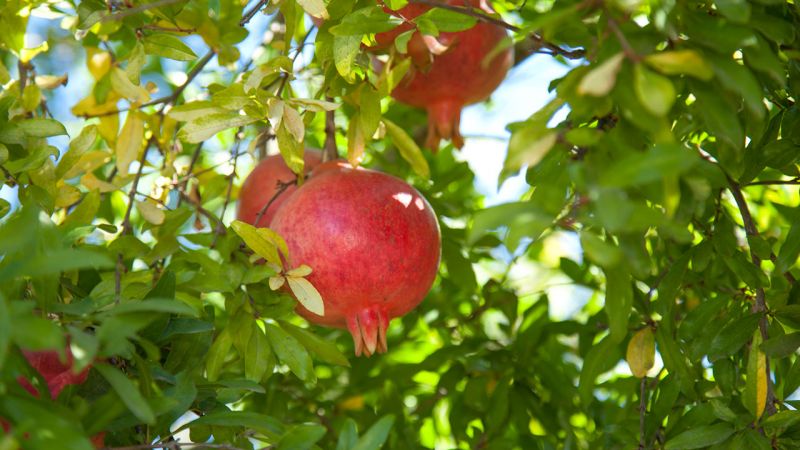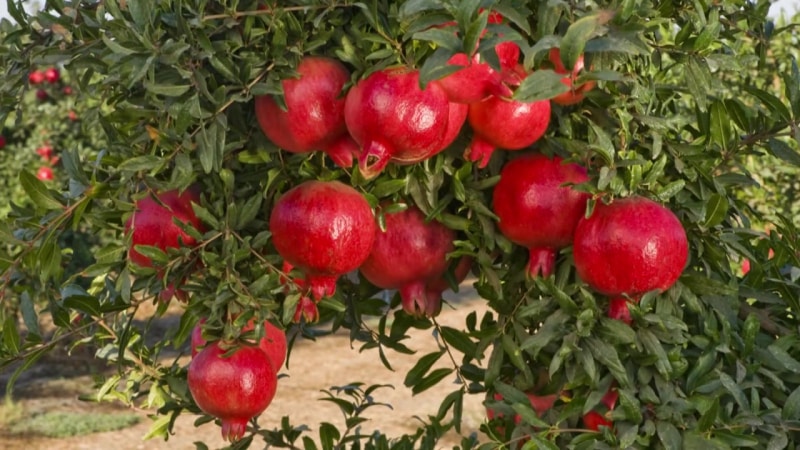What is a pomegranate, is it a citrus or not?
The Eastern king of all fruits, Carthaginian, granular and Punic apple are all names for pomegranate. The fiery red crown at the top of the fruit resembles a crown. According to one version, it was the fruit of the pomegranate tree that was the apple of paradise described in the Bible. In this article we will talk about the origin of the plant, its appearance, beneficial properties and harm.
What is pomegranate

What is a pomegranate, is it a citrus or not, or maybe a berry or fruit? Let's figure it out.
Pomegranate is usually called a fruit, however, according to the botanical classification, it is a berry. Hidden under the thick skin are many juicy grains with a seed inside, which is typical for berries.
The fruits grow on trees that resemble shrubs. Their height does not exceed 5-6 m, and the leaves are similar to lemon or tangerine. The fruits are the size of an average grapefruit.
How the name came about
Pomegranate (lat. punica) is a low tree from the genus of shrubs of the Derbennikov family. Previously, trees were considered monotypic and placed in the Pomegranate family (Punicaceae).
The fruits have the general name “pomegranates”. In botany there is a special definition for them - “pomegranates”.
Generic name punica comes from the Latin word punicus - that is, Punic or Carthaginian, due to its widespread distribution in the territory of modern Tunisia.
The Russian name “pomegranate” was based on the Latin word granatus – literally “grainy”. The ancient Romans called the plant malum punicum (“Punic apple”) and malum granatum (“grainy apple”).
Interesting! Residents of Ancient Greece believed that the first pomegranate tree was planted by the goddess of love Aphrodite. Until now, the Greeks have a tradition of breaking a pomegranate fruit at a wedding - a symbol of fertility.
Botanical description

Common pomegranate is a fruiting, deciduous, low-growing tree or shrub. 5-6 m high. Growing season – 6-8 months. It begins to bear fruit three years after planting.
The branches are prickly and thin. The leaves are smooth, glossy, oval, 3 cm long, green.
The flowers are funnel-shaped, orange-red, with a diameter of 2.5 cm or more. They contain the natural dye punicin.
Pomegranate flowers have three types:
- bisexual, pitcher-shaped, forming fruit ovaries;
- bell-shaped, not forming fruit ovaries;
- intermediate forms.
The calyx is leathery, with dense triangle-shaped lobes. Petals and stamens are fixed in the throat of the calyx. Style with thick lobed stigma.
The fruits are spherical in shape with a leathery pericarp and a calyx at the end. The peel is orange-yellow, red and brown-red depending on the variety. The diameter of the fruit is 15-18 cm. Numerous seeds (grains) are concentrated in 6-12 nests or chambers arranged in two tiers. One fruit contains 1000-1200 pieces. Each seed is in a juicy edible shell. The harvest from one tree is about 50 kg.
The culture is light-loving, requires bright sun without shading, and does not bloom when there is a lack of sunlight. Trees withstand frosts down to -15°C. Pomegranate is propagated seeds and cuttings.
A distinctive feature of the crop is the ability to form adventitious roots if the branches and trunk are covered with sand. The old rhizome gradually dies off.
History of the origin of culture
The Garnet genus arose at the end of the Cretaceous - beginning of the Tertiary period. The historical homeland of pomegranate is the territory of modern Tunisia, or Carthage. This is confirmed by documents dating back to 4000 BC. e. In Carthage, founded by the Phoenicians on the Mediterranean coast in 825 BC. e., pomegranate trees grew. After the conquest of the city by the Romans, its fruit began to be called the Punic apple.
Some sources contain information that the pomegranate spread from the territory of Persia (modern Iran).
Homer in the Odyssey twice mentions the pomegranate and speaks of it as a fruit tree common in those times in the gardens of Phrygia and Phenicia. Herodotus in his historical reports talks about the Persian attack on the Greeks and the personal guard of Xerxes called the pomegranate brigade. The soldiers proudly carried golden garnets on their spears as a sign of the highest honor.
Theophrastus describes the pomegranate in detail in his History of Plants. Culture is mentioned several times in the Old Testament. Pomegranate gardens were the pride of King Solomon and were sung in songs.
In Spain The pomegranate became a symbol of Granada's golden age. Modern plantings are a clear trace of the presence of Moorish tribes here. Granada is known all over the world thanks to the fame of its perfect varieties of pomegranate, cultivated in favorable climatic conditions.
In Central, North and South America, Australia and the islands of the Pacific and Indian Oceans, the plant appeared in the 16th-17th centuries.
In the countries of the former USSR pomegranate spread from Transcaucasia. The largest number of diverse wild fruit trees is represented in Turkmenistan, Uzbekistan, Tajikistan, Kyrgyzstan and Kazakhstan. During excavations of the Khorezm Toprak-Kala castle (beginning of the 4th century) under the leadership of S.P. Tolstov, archaeologists discovered an image of Anahita - the goddess of fertility - with pomegranates in her hand.
Reference. Egyptian pharaohs consumed pomegranate juice daily and believed that it strengthened the body and spirit.
Growing areas

In its wild form, the common pomegranate (Punica granatum) grows in Southern Europe and Western Asia.
His grow in Iraq, Afghanistan, India, China, Japan, Korea, Hawaii and Bermuda, Iran, Italy, Portugal, Spain, Greece, Azerbaijan, Georgia and Armenia, Tajikistan, Uzbekistan, France, Montenegro, Serbia, Croatia, Slovenia, Bosnia and Herzegovina, Macedonia.
In Russia, pomegranate is common on the Black Sea coast, in North Ossetia, Dagestan and Crimea.
Useful properties of pomegranate
Pomegranate has a rich vitamin and mineral composition, so when consumed regularly it has a beneficial effect on the body.
Benefits of grains:
- disinfectant properties of tannins;
- decreased activity of tuberculosis, intestinal and dysentery bacilli;
- elimination of diarrhea;
- strengthening the cardiovascular and nervous systems;
- prevention of influenza and ARVI;
- normalization of thyroid function;
- prevention of atherosclerosis;
- treatment of anemia, malaria;
- toning and general strengthening of the body;
- decreased blood pressure;
- reducing the risk of developing cancer;
- normalization of the condition of bronchial asthma and anemia;
- cleansing the body thanks to antioxidants;
- normalization of the gastrointestinal tract;
- increased hemoglobin levels;
- diuretic effect;
- assistance in the treatment of diseases of the lungs, liver, kidneys;
- elimination of headaches;
- skin rejuvenation;
- acceleration of cell renewal.
In addition to grains, juice and seeds, pomegranate peels and partitions are also eaten.
Reference. Dried peels are used to make a powder that has an astringent effect.It is used to treat enterocolitis, heal cracks and cuts. A decoction of the crusts helps cure colds, stomatitis, periodontal disease and remove parasites. Tea made from dried partitions helps to calm down and improve sleep.
Pomegranate has a number of contraindications for consumption:
- gastritis with high acidity;
- stomach ulcer;
- children under 1 year of age;
- haemorrhoids;
- chronic constipation.
Concentrated juice has a detrimental effect on tooth enamel due to its high acid content, so dentists recommend partially diluting it with water and drinking through a straw.
Chemical composition

The table shows the vitamin and mineral composition of pomegranate seeds per 100 g.
| Name | Content | Norm per day |
| Vitamin A | 5 mcg | 900 mcg |
| Beta carotene | 0.03 mg | 5 mg |
| Vitamin B1 | 0.04 mg | 1.5 mg |
| Vitamin B2 | 0.01 mg | 1.8 mg |
| Vitamin B4 | 7.6 mg | 500 mg |
| Vitamin B5 | 0.54 mg | 5 mg |
| Vitamin B6 | 0.5 mg | 2 mg |
| Vitamin B9 | 18 mcg | 400 mcg |
| Vitamin C | 4 mg | 90 mg |
| Vitamin E | 0.4 mg | 15 mg |
| Vitamin H | 0.4 mcg | 50 mcg |
| Vitamin K | 16.4 mcg | 120 mcg |
| Vitamin PP | 0.5 mg | 20 mg |
| Niacin | 0.4 mg | — |
| Potassium | 150 mg | 2500 mg |
| Calcium | 10 mg | 1000 mg |
| Silicon | 5 mg | 30 mg |
| Magnesium | 2 mg | 400 mg |
| Sodium | 2 mg | 1300 mg |
| Sulfur | 16.7 mg | 1000 mg |
| Phosphorus | 8 mg | 800 mg |
| Chlorine | 2 mg | 2300 mg |
| Aluminum | 110 mcg | — |
| Bor | 54.4 mcg | — |
| Vanadium | 14 mcg | — |
| Iron | 1 mg | 18 mg |
| Iodine | 2 mcg | 150 mcg |
| Cobalt | 2.1 mcg | 10 mcg |
| Lithium | 0.9 mcg | — |
| Manganese | 0.119 mg | 2 mg |
| Copper | 158 mcg | 1000 mcg |
| Molybdenum | 5.1 mcg | 70 mcg |
| Nickel | 1.8 mcg | — |
| Rubidium | 37.6 mcg | — |
| Selenium | 0.5 mcg | 55 mcg |
| Strontium | 19.4 mcg | — |
| Fluorine | 58.7 mcg | 4000 mcg |
| Chromium | 1.5 mcg | 50 mcg |
| Zinc | 0.35 mg | 12 mg |
| Zirconium | 6.1 mcg | — |
Nutritional value of the product per 100 g:
- calorie content – 72 kcal;
- proteins – 0.7g;
- fats – 0.6 g;
- carbohydrates – 14.5 g;
- organic acids – 1.8 g;
- fiber – 0.9 g;
- water – 81 g.
Read also:
How to properly prune a peach in the fall and why it is needed.
Compatibility of watermelon with milk and other products.
What is buckwheat, why is it good and what dishes is it suitable for.
Conclusion
Is pomegranate a citrus fruit or not? According to the botanical description, it is a berry. Grains, peels and partitions contain vitamins and minerals, organic acids, and about 28% tannins. The incredible benefits for the body are due to its rich chemical composition.
Pomegranate has an analgesic, antipyretic, wound-healing, antiseptic, antisclerotic, choleretic, anti-inflammatory, astringent, anthelmintic, and tonic effect.